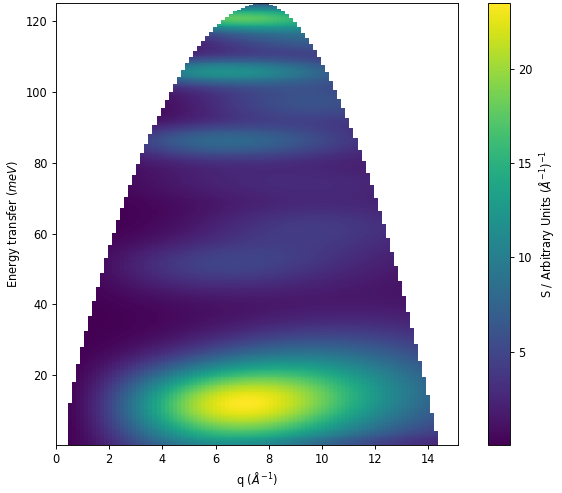Direct Geometry Changes¶
General¶
New Features¶
CorrectTOFAxis can now accept fractional bin indices for more precise calculation of the elastic peak position calibration.
DirectILLCollectData will now accept fractional elastic peak reference bins as well as forward fractional elastic peak indexes in the CorrectTOFAxis algorithm.
DirectILLApplySelfShielding now ensures that the subtracted container and self-attenuation correction workspaces have consistent binning by rebinning to the sample that will be corrected.
LoadPLN now supports the loading of ANSTO PELICAN data during event capture mid-experiment, as a cross check for long experiments.
Bugfixes¶
The sign of the half-channel width in the LoadILLTOF algorithm has been changed from negative to positive to ensure the TOF axis is always positive.
The PyChop interface has been adjusted to ensure that the command-line version functions as described in the documentation.
DirectILLCollectData will now be able to load data with whitespaces in paths or file names.
Algorithms¶
New Features¶
A new Abins2D algorithm has been added for simulation of inelastic neutron scattering in direct-geometry
This employs the same almost-isotropic analytic powder-averaging incoherent approximation as Abins.
The ISIS MARI, MAPS, and MERLIN instruments are supported, alongside ILL-PANTHER and a
TwoDMapideal simulation. Please direct requests/specifications for additional instruments to Sanghamitra Mukhopadhyay and Adam Jackson.The algorithm produces workspaces in \((Q,\omega)\) space, best viewed interactively in Sliceviewer, or rendered as colorfill plots.

DirectILLAutoProcess now performs the full data reduction treatment for ILL direct geometry instruments for an empty container, vanadium, and sample, both for single crystal and powder.
DirectILLCollectData has two new properties:
GroupDetHorizontallyByandGroupDetVerticallyBywhich allow for averaging pixel counts between the tubes and inside them, respectively, or for flat background calculations.Autoscaling has been added to the PelicanReduction algorithm to ensure that the Q range matches the energy transfer, as is default in the UI.
CrystalField¶
New Features¶
The Crystal Field Python interface has been extended to include functions to calculate the x, y, and z components of the dipole transition matrix:
getXDipoleMatrixComponent(),getYDipoleMatrixComponent()andgetZDipoleMatrixComponent().
MSlice¶
New Features¶
The documentation has been improved to include more up-to-date screenshots and more information about cutting methods.
The programme is now available as a noarch conda package.
MSlice is now compatible with
matplotlib 3.5.0.Slice plot font sizes can now be changed using the quick options.
Improved the error message for empty cut plot axes.
Modified the default Bragg peak size for interactive cut plots.
Improved zooming speed for slice plots with recoil lines.
Improved handling of default line widths.
Bugfixes¶
The Default Energy Unit menu is no longer empty.
The
Show Legendcheck boxes now appear with the correct state.Fixed colorbar crash when changing scale to logarithmic with negative
vmaxvalue and/or negative/0vminvalue.Fixed a bug that prevented
vminfrom updating when unticking logarithmic scale.Fixed a problem with ignored Bragg peaks on interactive cut plots when flipping axes.
Fixed a bug that caused a runtime error when changing between workspaces from same dataset.
Fixed an issue with re-opening line dialog for cut plots.
Fixed bug that caused an error when changing the scale to logarithmic for cut plots with Bragg peaks.
Max and min axes values will no longer take strings or empty strings instead of doubles.
Dialogue boxes for quick options and plot options now stay on top of the plot window.
Fixed a bug causing error messages when loading OSIRIS data.
Fixed problem with the deletion of overplotted lines.
Included a fix for to prevent Bragg peaks being duplicated when overplotting cut plots.
Fixed the scaling of Bragg peaks on plots with logarithmic scales.